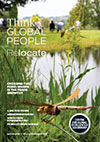The future of international mobility
Although the Covid 19 pandemic has slowed down international mobility, organisations still require global moves to fill skills gaps and develop their future leaders. What are the recent changes that are shaping the future of international mobility?

The talent and global mobility link
Links between the talent function and global mobility professionals are continuing to strengthen and this will have positive consequences for individuals’ international careers. The talent function is serving the business though the identification of critical competencies while global mobility plays its part in ensuring their deployment internationally is compliant and provides an excellent employee experience. But the talent/global mobility link is deeper than this – global mobility can guide and support the talent function both in selection of international personnel and understanding their motivations and hesitations concerning their move abroad.As the talent and global mobility functions work increasingly closely together so this helps to improve and smooth the relocation experience for those pursuing international careers. This indicates that those undertaking international assignments in future will benefit from a more positive relocation experience.Agility and flexibility
Organisations are increasingly pursuing an agile culture that enables global mobility to operate both efficiently and effectively satisfying both the needs of the business and of employees and their families.It is notable that policy supporting global mobility is changing to provide a more supportive function. Rather than policy being restrictive in categorising what is allowed and what is not in terms of financial and practical support, the emphasis is moving towards a more ‘guidelines’ style of approach that facilitates fairness and equity and supports individual needs.Policies and guidelines are also increasingly reflective of the purpose of the assignment rather than being linked to employee grade. This is also helpful to those undertaking international mobility as the purpose of their assignment is related more closely to the financial and practical support on offer.Flexibility in determining and providing employee support has become integral to successful moves. Again this is a positive development for those following an international career as support becomes increasingly tailored to individual and family needs while remaining within an equitable framework that supports business objectives.Related articles and factsheets:
- Managing Across Cultures: Guiding Principles & Developing a Global Mindset
- Relocation policy design and review principles factsheet
- Managing mobile careers and career pathing factsheet
- Focusing on the family: policy issues in the Covid-19 era
Identifying talent
The requirements of the business of course always come first – and subsidiaries need the best talent possible. This can flow from an open recruitment and selection process but also from a requested employee move approach. Here the talent and global mobility professionals play a critical role in understanding employee and family motivations to move. They should not be afraid to say ‘no’ when a move is not in the best interests of the business or the individual concerned.Mobility is a great connector and a wide range of stakeholders are involved in the process. As such relationship building is crucial to successful mobility support. This is advantageous to individuals on the move as the efforts being put into building relationships – for example with suppliers external to the business and different functions within it such as reward and talent – have a positive spin off for those undertaking relocation. Increasingly there is recognition of the value of communication in building and strengthening stakeholder relationships and individuals and their families who are relocating will find this beneficial.Types of international moves
A further area that is changing is the nature of the international move. Organisations are increasingly looking towards local hires to fulfil international roles (potentially using both local and foreign nationals in-country) given the pandemic and its effect on cross-border moves. There is also increased emphasis on working from home and/or working from anywhere. Besides the obvious issues of tax and immigration compliance, these issues influence remuneration packages given as well.Employee requested moves are also being given increased prominence – but here again, there has to be a focus on feasibility in terms of compliance and also the effects on individuals and families of taking up such work arrangements. Online or virtual international assignments have increased significantly during the pandemic and may continue in popularity, although this will depend on the nature of the job role and whether physical presence is required on site.Diversity and inclusion
Minorities have traditionally been under-represented in the international assignee profile and this is an untapped source of talent that organisations simply cannot ignore. The pandemic resulted in more international roles being fulfilled by working from home, online. This widened out the future for international working to a wider range of minorities who previously found themselves unable to undertake (or excluded from) international opportunities.As a result, there has been increased organisational emphasis on diversity and inclusion within the international mobility arena. Going forward this is likely to be well supported through more transparent and flexible approaches to policy as well as deployment options. It is notable too that organisations are looking beyond traditional diversity issues. So while gender and LGBTQ diversity continues to receive considerable attention, it is notable now that organisations are widening their horizons and considering race, religion and disability within their assignee profiles as well.Technology and global mobility
A further issue that is assisting with the deployment of personnel internationally is the development of technology to support flexible approaches to policy content delivery. Technology is enabling a guideline approach to policy content to be delivered to support individual needs within budgets in a transparent manner. It also enables the global mobility function to leverage data to demonstrate cost/benefit analyses to the business.As technological solutions continue to be developed, so the ease and convenience of pre-move tasks will be supported. Home and school finding, the relocation of personal effects, temporary living and a whole host of other factors that have to be considered by those moving internationally can be managed (at least in the first instance) from the comfort of the armchair rather than necessitating physical moves to visit in person. Of course, the benefits of seeing the destination, its culture and its facilities first hand cannot be negated, preliminary screening using technology saves time, cost and effort for businesses and their relocating employees and families. Thus, technological developments will help improve and smooth the international mobility process going forward.Communications: how can companies improve?
Organisations’ efforts to improve communications between stakeholders have been given a boost during the pandemic. We have all become more used to working online with zoom and teams meetings. Paradoxically being unable to meet face-to-face has resulted in increased communications linking people who before might not have been able to attend meetings and participate in decision-making. Going forward, an emphasis on networking and sharing information should increase.We have become more accustomed to information availability and this is to be welcomed. Of course, information overload brings with it the dangers of fatigue and so care needs to be taken to ensure communications are appropriate and worthwhile. Nonetheless, international careers in the future can be supported by the use of relevant communications, hopefully ending the ‘out of sight, out of mind’ syndrome associated with global mobility in the past.Repatriation
No commentary on the future of international mobility would be complete without mention of returning home. This must be taken more seriously in global talent deployment. Repatriation has received considerable attention during the pandemic in relation to health, welfare and well-being. For example, emphasis has been placed on the need to manage personnel trapped abroad by border closures and visa restrictions on mobility. This has highlighted the need to be sure of where people are and to have plans in place for evacuation – aspects that have definitely been taken on board by global mobility professionals.Going forward though repatriation must be more proactively managed – we need to look beyond emergency situations to active career planning and relocation preparation and support for those returning at the end of their assignments. Successful repatriation results in talent retention and positive business benefits. It also results in employee and family well-being.The future of international mobility must ensure a strong focus on a positive repatriation experience. Repatriation is an integral part of the expatriation cycle. Complete it successfully and it supports future global mobility and successful outcomes for businesses and individuals alike.Subscribe to Relocate Extra, our monthly newsletter, to get all the latest international assignments and global mobility news.Relocate’s new Global Mobility Toolkit provides free information, practical advice and support for HR, global mobility managers and global teams operating overseas.
 Access hundreds of global services and suppliers in our Online Directory
Access hundreds of global services and suppliers in our Online Directory
©2025 Re:locate magazine, published by Profile Locations, Spray Hill, Hastings Road, Lamberhurst, Kent TN3 8JB. All rights reserved. This publication (or any part thereof) may not be reproduced in any form without the prior written permission of Profile Locations. Profile Locations accepts no liability for the accuracy of the contents or any opinions expressed herein.







































